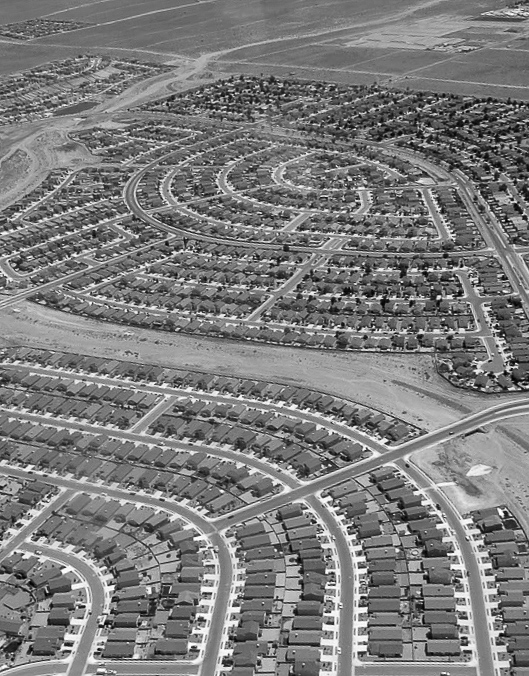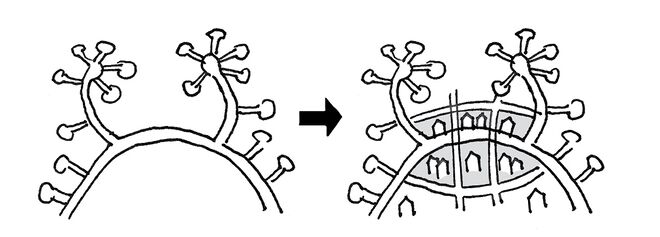13.2. Sprawl Retrofit
Aus Pattern Language Wiki
Within the Polycentric Region, one of the most important tasks is to improve the urban quality of many suburban areas.
Problem-statement: The existing suburban regions that are low-density, segregated by use and by population, high-consumption, fragmented and dysfunctional, represent one of the greatest land resources for the future. But the challenge of retrofitting and urbanizing these areas is enormous, with many barriers remaining.
Discussion: The sprawling suburbs represent a large and growing percentage of the world’s population, particularly in countries like the USA where auto-dependent suburban development has dominated for decades.
One challenge is that existing owners are resistant to change, and political processes therefore often inhibit urbanization. But there are economic mechanisms to promote urbanization, including developing attractive new urban centers on adjacent empty land such as parking lots and unneeded right of way. Another strategy is to acquire future easements that do not go into effect for the foreseeable future, and that property owners will therefore be more willing to sell or otherwise grant permission.
Another significant barrier is the holdover of zoning codes and laws from a period when sprawling development was seen as more benign than it is now. A key challenge is that sprawling development is still very profitable, even to city bureaucracies in the form of increased fees and tax base. This means it is necessary to find ways to change the “operating system”, especially by changing the economic incentives and disincentives. For example, taxes, fees, system development charges, and other mechanisms can help to make good-quality urbanism more cost-competitive in these suburban locations.
In addition to the legal mechanisms, we must also be clear about the geometry that we wish a sprawling suburb to evolve towards. That geometry is described by other patterns in this book (400M Through Street Network, Public Space System, Walkable Streetscape, Terminated Vista, et al.). We can also describe it as a geometry of organized complexity, of diversity and inhomogeneity, where the urban fabric forms overlapping heterogeneous zones that support mixed activities and uses. The first indicator that newly-implemented legal incentives are working to “fix” the sprawling suburb is a departure from the original homogeneous urban footprint.
Therefore:
Find creative ways to retrofit suburban sprawl, by creating new infill development, by re-using declining malls, empty parking lots and other under-utilized sites, and by changing old zoning laws, standards, codes and charges. Find new economic incentives and other creative mechanisms to fund good projects.
Use Tax-Increment Financing and Land Value Capture to make good-quality urbanization more competitive, and more likely to proceed. …
¹ Several books have appeared recently with many ideas about retrofitting suburbia — for example see Dunham-Jones, E., & Williamson, J. (2008). Retrofitting Suburbia: Urban design solutions for redesigning suburbs. New York: John Wiley & Sons. For a compendium of ideas for retrofits, see Tachieva, G. (2010). Sprawl Repair Manual. Washington D.C.: Island Press. A number of design techniques are also discussed in Steil, L., Salingaros, N., and Mehaffy, M. (2008). Growing Sustainable Suburbs: An incremental strategy for retrofitting sprawl. In Haas, T. (ed.), New Urbanism and Beyond. New York: Rizzoli. Available on the Web at http://zeta.math.utsa.edu/~yxk833/suburbia.pdf
Mehaffy, M. et al. (2020). SPRAWL RETROFIT (pattern). In A New Pattern Language for Growing Regions. The Dalles: Sustasis Press. Available at https://pattern-language.wiki/.../Sprawl_Retrofit
SECTION I:
PATTERNS OF SCALE
1. REGIONAL PATTERNS
Define the large-scale spatial organization…
1.4. 400M THROUGH STREET NETWORK
2. URBAN PATTERNS
Establish essential urban characteristics…
3. STREET PATTERNS
Identify and allocate street types…
4. NEIGHBORHOOD PATTERNS
Define neighborhood-scale elements…
5. SPECIAL USE PATTERNS
Integrate unique urban elements with care…
6. PUBLIC SPACE PATTERNS
Establish the character of the crucial public realm…
7. BLOCK AND PLOT PATTERNS
Lay out the detailed structure of property lines…
8. STREETSCAPE PATTERNS
Configure the street as a welcoming place…
9. BUILDING PATTERNS
Lay out appropriate urban buildings…
10. BUILDING EDGE PATTERNS
Create interior and exterior connectivity…
10.1. INDOOR-OUTDOOR AMBIGUITY
SECTION II:
PATTERNS OF MULTIPLE SCALE
11. GEOMETRIC PATTERNS
Build in coherent geometries at all scales…
11.2. SMALL GROUPS OF ELEMENTS
12. AFFORDANCE PATTERNS
Build in user capacity to shape the environment…
13. RETROFIT PATTERNS
Revitalize and improve existing urban assets …
14. INFORMAL GROWTH PATTERNS
Accommodate “bottom-up” urban growth…
15. CONSTRUCTION PATTERNS
Use the building process to enrich the result…
SECTION III:
PATTERNS OF PROCESS
16. IMPLEMENTATION TOOL PATTERNS
Use tools to achieve successful results…
16.2. ENTITLEMENT STREAMLINING
16.3. NEIGHBORHOOD PLANNING CENTER
17. PROJECT ECONOMICS PATTERNS
Create flows of money that support urban quality…
17.4. ECONOMIES OF PLACE AND DIFFERENTIATION
18. PLACE GOVERNANCE PATTERNS
Processes for making and managing places…
18.3. PUBLIC-PRIVATE PLACE MANAGEMENT
19. AFFORDABILITY PATTERNS
Build in affordability for all incomes…
19.1. INTEGRATED AFFORDABILITY
20. NEW TECHNOLOGY PATTERNS
Integrate new systems without damaging old ones…
20.2. RESPONSIVE TRANSPORTATION NETWORK COMPANY

